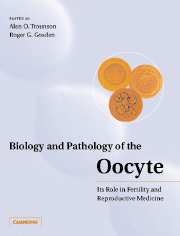Book contents
- Frontmatter
- Contents
- List of contributors
- Preface
- Part I Historical perspective
- Part II Life cycle
- Part III Developmental biology
- Part IV Pathology
- 13 Morphology and pathology of the human oocyte
- 14 The legacy of mitochondrial DNA
- 15 Aneuploidy in ageing oocytes and after toxic insult
- 16 Genetic basis of primary ovarian failure
- Part V Technology and clinical medicine
- Index
15 - Aneuploidy in ageing oocytes and after toxic insult
from Part IV - Pathology
Published online by Cambridge University Press: 05 August 2016
- Frontmatter
- Contents
- List of contributors
- Preface
- Part I Historical perspective
- Part II Life cycle
- Part III Developmental biology
- Part IV Pathology
- 13 Morphology and pathology of the human oocyte
- 14 The legacy of mitochondrial DNA
- 15 Aneuploidy in ageing oocytes and after toxic insult
- 16 Genetic basis of primary ovarian failure
- Part V Technology and clinical medicine
- Index
Summary
Introduction
Aneuploidy in human oocytes is one of the major aetiological factors in the conception of a trisomic embryo, pre- and postimplantation failure, spontaneous abortion and inheritable genetic disease in the human (Bond and Chandley, 1983; Jacobs, 1992). At least 15-20% of all concepti are estimated to be chromosomally unbalanced (Jacobs, 1992; Eichenlaub-Ritter, 1998), giving rise to reduced developmental potential, congenital abnormalities, mental retardation and reduced life expectancy in affected children. Trisomies most commonly surviving to birth are trisomy 21 (Down's syndrome), trisomy 18 (Edward's syndrome), trisomy 13 (Patau syndrome) and aneuploidies of the sex chromosomes (e.g. 45X, Turner's syndrome). The most common trisomy giving rise to spontaneous abortion is that of trisomy 16 (Hassold et al, 1980).
Since half a century ago, it has been known that aneuploidy increases dramatically with maternal age and is a major factor in reduced fertility in women, but at the physiological level the aetiological factors are still largely unknown. Retrospective and prospective analyses all come to the conclusion that errors predominantly in chromosome segregation at first meiosis of oogenesis and aneuploidy in human oocytes are responsible for chromosomal imbalance in the embryo. Analysis of the origin and recombinational history of extra chromosomes in trisomic conceptuses has by now provided valuable information on the origin of aneuploidy and some correlated factors while the pathological condition of the human oocyte giving rise to a susceptibility to nondisjunction is still under investigation. Information on the origin of errors in chromosome segregation has been obtained in recent years by the genetic analysis of spare or donated human oocytes which become available in assisted reproduction. Moreover, new methods to assess the chromosomal constitution of preimplantation embryos have been developed which provide information on the origin and fate of chromosomally unbalanced embryos. Culture methods and techniques for monitoring spindle formation and chromosome behaviour have improved such that human or other mammalian oocytes can now be matured in vitro and evaluated for pathological features. Naturally occuring mutations and targeted mutagenesis in mice and genetically well-defined organisms like yeast and Drosophila, as well as studies with oocyte cell extracts, have all provided insights into the mechanisms responsible for stringent control and fidelity of chromosome segregation and the aetiological factors in aneuploidy in mammalian oocytes.
- Type
- Chapter
- Information
- Biology and Pathology of the OocyteIts Role in Fertility and Reproductive Medicine, pp. 220 - 257Publisher: Cambridge University PressPrint publication year: 2003
- 5
- Cited by



